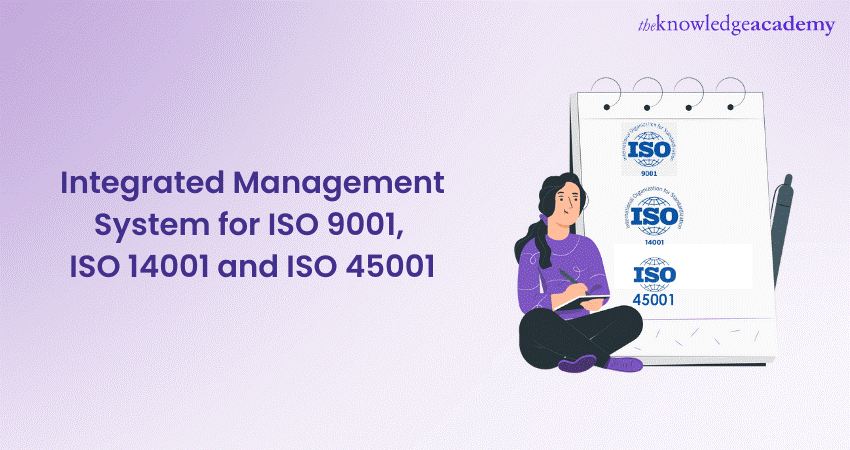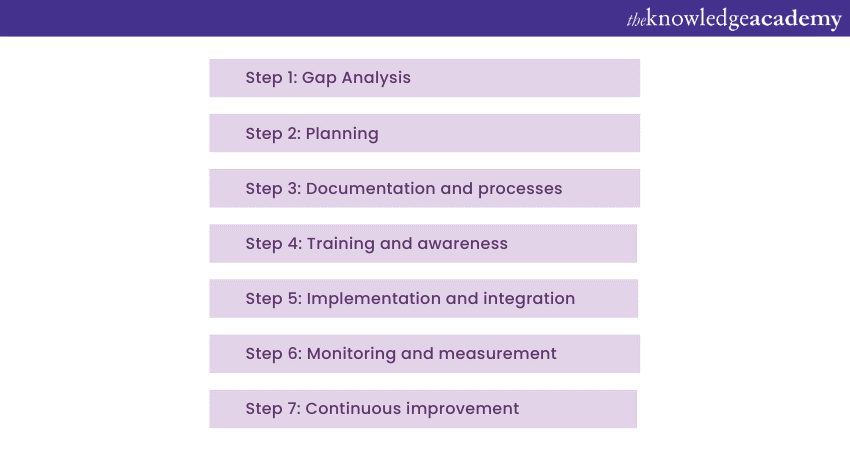We may not have the course you’re looking for. If you enquire or give us a call on 01344203999 and speak to our training experts, we may still be able to help with your training requirements.
Training Outcomes Within Your Budget!
We ensure quality, budget-alignment, and timely delivery by our expert instructors.

A modern-day organisation needs to meet several standards to maintain its competitive edge in the industry including the ISO 14001 Context of the organisation. exploring differences in ISO 14001 Version 2004 vs 2015, to maintain its competitive edgeThese include effective Quality, Environmental, and Occupational Health and Safety Management.To fulfil all these requirements, businessses often resort to a comprehensive approach that helps integrate all the standards to promote efficiency.
This blog explores the power of Integrated Management Systems (IMS), their benefits and implementation strategies for integrating ISO 9001, ISO 14001, and ISO 45001. Understand the essentials of Integrated Management System for ISO 9001, ISO 4001, and ISO 45001, their benefits, differences and how to implement them. Read on to learn more!
Table of Contents
1) What is an Integrated Management System?
2) How to implement an Integrated Management System?
a) Step 1: Gap Analysis
b) Step 2: Planning
c) Step 3: Documentation and processes
d) Step 4: Training and awareness
e) Step 5: Implementation and integration
f) Step 6: Monitoring and measurement
g) Step 7: Continuous improvement
3) What is the need for an ISO 9001, ISO 45001 and ISO 14001 Certification?
4) Conclusion
What is an Integrated Management System?
This section of the blog will tell you all you need to know about an IMS, including its objectives and the benefits it offers to an organisation.
An overview of an IMS
An Integrated Management System (IMS) is a comprehensive approach that combines multiple management systems within an organisation to create a unified framework. It allows businesses to integrate various standards, processes, and procedures into a cohesive system that promotes efficiency, effectiveness, and compliance ISO 14001 Compliance for streamlined environmental managementThe primary goal of an IMS is to streamline operations, reduce duplication of efforts, and enhance overall performance across different areas of management.
At its core, an IMS brings together the principles and requirements of multiple standards, such as ISO 9001 (Quality Management System), ISO 14001 (Environmental Management System), and ISO 45001 (Occupational Health and Safety Management System). By integrating these standards, organisations can benefit from a harmonised and holistic approach to managing quality, environmental impact, as well as occupational health and safety aspects.
Benefits of implementing an IMS
This section of the blog will expand on the benefits that IMS provides to an organisation:
1) Efficiency and resource optimisation: An IMS eliminates redundancies and duplication of efforts by integrating various management systems. This streamlines processes reduces paperwork, and eliminates unnecessary tasks, improving efficiency and resource optimisation. It enables employees to focus on value-added activities, leading to increased productivity.
2) Consistency and standardisation: By aligning procedures and practices according to common requirements, an IMS promotes consistency and standardisation throughout the organisation. This ensures that operations are carried out consistently across different departments and locations with ISO 14001 Document Control. Standardised processes enhance quality, reduce errors, and facilitate better control and traceability.
3) Improved Risk Management: An IMS provides a holistic framework for managing risks and opportunities. By integrating quality, environmental, and occupational health and safety aspects, organisations can identify and assess risks in a comprehensive manner. This allows for a more effective Risk Management strategy, minimising potential hazards and ensuring the safety of employees, customers, and the environment.
4) Enhanced compliance: Compliance with multiple standards can be complex and time-consuming. However, an IMS simplifies the compliance process by integrating the requirements of various standards into a single system. This makes ensuring adherence to legal and regulatory obligations easier, reducing the risk of non-compliance and associated penalties aligning with ISO 14001 principles that encompass both environmental ISO 14001 Risks and Opportunities.
5) Streamlined Audits and assessments: IMS makes Auditing and assessment processes more efficient and effective. Instead of conducting separate Audits for different management systems, organisations can perform integrated Audits that cover all relevant areas. This saves time, reduces disruption, and provides a holistic view of the organisation's performance.
6) Improved communication and collaboration: An IMS fosters better organisational communication and collaboration. By integrating different functions and departments, employees have a shared understanding of processes, objectives, and requirements. This promotes cross-functional collaboration, information sharing, and a collective effort towards achieving organisational goals.
7) Cost savings: Implementing an IMS can lead to cost savings in various ways. By eliminating redundancies and optimising resources, organisations can reduce operational costs. Standardising processes and practices can also lead to cost reductions by minimising errors, rework, and wastage. Additionally, effective risk management reduces the likelihood of costly incidents and liabilities.
8) Enhanced reputation and stakeholder confidence: Implementing an IMS demonstrates an organisation's commitment to quality, environmental sustainability, and occupational health and safety. This enhances its reputation and builds stakeholder confidence, including customers, suppliers, employees, regulatory bodies, and the community at large. It positions the organisation as a responsible and trustworthy entity.
Want to drive sustainable change in your organisation? Sign up for our ISO 14001 Lead Auditor Course now!
How to implement an Integrated Management System?
Implementing an IMS requires careful planning, coordination, and effective execution. Here are the steps involved in implementing an IMS:

Step 1: Gap Analysis
The first step in implementing an IMS is conducting a thorough Gap Analysis. This involves assessing the existing management systems in the organisation against the requirements of ISO 9001, ISO 14001, and ISO 45001. The purpose is to identify gaps and areas that need improvement to meet the standards. This analysis helps organisations understand their current state and sets the foundation for developing an effective implementation plan.
Step 2: Planning
Once the gaps are identified, organisations need to develop a comprehensive implementation plan. This plan outlines the objectives and targets for the IMS implementation, sets timelines, and allocates resources. It also identifies the responsible stakeholders and defines their roles and responsibilities. Planning is crucial for ensuring a smooth and systematic integration of the ISO standards into the organisation's processes.
Step 3: Documentation and processes
Documentation plays a vital role in the implementation of an IMS. It involves documenting procedures, policies, and processes to align with ISO 9001, ISO 14001, and ISO 45001 requirements. This documentation ensures clarity, consistency, and standardisation throughout the organisation. It should include aspects such as quality management, environmental management, risk assessment, occupational health and safety, and compliance.
Step 4: Training and awareness
Organisations must provide training and create employee awareness to implement an IMS successfully. Training programs should focus on familiarising employees with the integrated system, explaining their roles and responsibilities, and building their skills to meet the requirements of ISO Standards. Awareness campaigns help employees understand the benefits of an IMS, encourage active participation, and foster a culture of continuous improvement.
Step 5: Implementation and integration
Once the documentation is complete and employees are trained, the actual implementation of the IMS begins. This involves deploying the integrated system across the organisation, aligning processes with the ISO Standards, and integrating quality, environmental, and occupational health and safety requirements. It requires close collaboration between different departments to ensure consistency and coherence throughout the organisation.
Step 6: Monitoring and measurement
Monitoring and measuring performance is a critical aspect of an IMS. Key Performance Indicators (KPIs) should be established to track progress and ensure compliance with the ISO Standards. Regular ISO 14001 Audits should be conducted to identify areas for improvement and take corrective actions. Monitoring and measurement help organisations evaluate the effectiveness of the IMS and identify opportunities for enhancement.
Step 7: Continuous improvement
Continuous improvement is at the heart of an IMS. Organisations should foster a culture of ongoing improvement, where feedback is encouraged and lessons learned are incorporated into the system. By implementing corrective actions and continuously striving for excellence, organisations can enhance the effectiveness and efficiency of their integrated system.
What is the need for an ISO 9001, ISO 45001 and ISO 14001 Certification?
For businesses striving for efficiency, profitability, and social responsibility, embracing ISO management systems like ISO 9001, ISO 45001, and ISO 14001 is a wise choice. The beauty of these standards lies in their integration potential – they can harmoniously coexist and complement each other.
ISO 9001 primarily deals with Quality Management. It's your go-to system for ensuring that your products and services consistently meet customer requirements and adhere to applicable regulations. ISO 45001, on the other hand, is the linchpin for Occupational Health and Safety Management, setting the stage for a secure workplace and risk reduction. ISO 14001Environmental Management within the ISO 14001 Life Cycle, propels your efforts toward sustainability by helping you Integrated ISO 14001 Software minimizes the environmental footprint and fosters eco-friendly practices seamlessly.
While these standards address different facets of organisational excellence, they share common ground – a commitment to improvement. By implementing all three systems, you demonstrate an unwavering dedication to safety, quality, and environmental responsibility. Moreover, they aren't static; they adapt to your business, providing room for innovation and continual enhancement.
In essence, these ISO management systems are a trifecta that not only optimises your operations but also ensures you're a responsible corporate citizen, contributing to the well-being of your stakeholders and the environment.
Take the first step towards ISO 14001 compliance with our ISO 14001 Foundation Course. Join now!
Conclusion
In conclusion, an Integrated Management System (IMS) that amalgamates the ISO 9001, ISO 14001, and ISO 45001 Benefits organisations. By aligning these standards and integrating their requirements, businesses can streamline their processes, improve efficiency, and enhance overall performance. Implementing an IMS involves several steps, including Gap Analysis, planning, documentation, training, implementation, monitoring, and continuous improvement. While challenges may arise during the implementation process, they can be overcome by following the abovementioned guidelines.
Enhance your organisation's Environmental Management practices with our comprehensive ISO 14001 Training. Register today!
Frequently Asked Questions
Upcoming Business Improvement Resources Batches & Dates
Date
 ISO 14001 Foundation Certification
ISO 14001 Foundation Certification
Mon 17th Jun 2024
Mon 21st Oct 2024
Mon 6th Jan 2025
Mon 7th Apr 2025
Mon 4th Aug 2025
Mon 3rd Nov 2025







 Top Rated Course
Top Rated Course



 If you wish to make any changes to your course, please
If you wish to make any changes to your course, please


